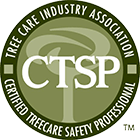“What’s this? Another tree/branch/large shrub in my yard that wasn’t there before the storm? I better gas up my brother’s old chain saw and go cut it up.”
Stop! Just don’t.
Yet another storm has brought distress into your yard in the form of large branches and even entire trees that have broken and fallen into your world view. Before you dig out your brother’s old chain saw, the first question should be, “Am I capable of removing this large tree/limb myself or should I seek professional help?” Major tree-damage cleanup will undoubtedly require the use of a chain saw and climbing equipment. Unless you are experienced in the use of such equipment and comfortable working off the ground, it would be best to have the work performed by a competent professional.
Wind places loads on trees, including trunks, branches and roots, leading to higher stress. The varying lengths and sizes of tree branches tend to dampen the overall effects of wind; however, as wind speeds increase, the loads placed on stress points within the tree increase exponentially. When the loads exceed trunk, branch or root strength, various types of failures occur.
But my brother’s chain saw is right here – it wouldn’t take me long at all!
It might be tempting to get out there with your brother’s old chain saw and do the work yourself. And this is where so many homeowners get into trouble. Run an internet search for videos of “tree cutting gone wrong” to see just what can happen.
I’ve used a chain saw before to cut up an old fence. What could possibly go wrong if I cut up this giant tree branch in my yard?
PROFESSIONALLY TRAINED TREE WORKERS HAVE TO KNOW WHAT TO LOOK OUT FOR. DO YOU?
• There could be overhead and/or nearby electrical wires that create potential hazards and limit the options for tree cutting. Torn, hanging limbs overhead could make it extremely dangerous to cut downed limbs underneath them.
• Most chain saw work on large limbs or trees requires the experience of a trained operator to prevent injuries. Wood under tension (one or both ends of the fallen tree or branch pinned under other branches or debris) can have different types of binds at different places. Releasing that tension with chain saw cuts is extremely dangerous and can seriously, or fatally, harm the chain saw operator.
• Uprooted root plates or root balls are unpredictable. Cutting the trunk of a fallen tree from an uprooted plate releases the pressure holding the root plate. The roots are still anchored and may have enough tension that they will pull the stump and root ball back into the hole. It could suddenly sit back into the root hole, trapping anything nearby underneath it.
• Slope and uneven footing surfaces are dangerous while operating a chain saw.
• Watch that bar tip! Cutting branches on the ground can cause you to bury the saw bar in the dirt or hit hidden obstacles, causing chain saw kickback.
• Many homeowners injured doing their own tree work were working alone at the time, significantly lengthening emergency response time and hospital stays. Always have at least one other person work with you. In case you get trapped or injured, there’s someone to call for help.
Removing large, fallen trees should always be done by an experienced professional.
FIND A PROFESSIONAL
A professional arborist can determine the best way to accomplish the task at hand, and has the experience and proper equipment to do the job. And in doing so, he or she just may prevent an injury or even save a life.
Call us for your free consultation at 919-355-8299 or visit us at CSTreeServices.com.
Editorial Credit: www.treecaretips.org






